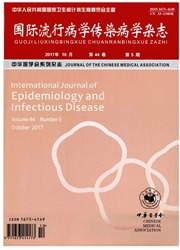

 中文摘要:
中文摘要:
目的 探讨拉米夫定联合还原型谷胱甘肽预防HBV携带者抗结核病治疗时的肝损害效果。方法结核病患者伴HBV携带90例,随机分为A、B、C三组,每组30例,其中A组抗结核治疗前应用拉米夫定片抗病毒联合还原型谷胱甘肽针保肝,B组应用还原型谷胱甘肽针保肝治疗,C组应用益肝灵片保肝治疗,观察治疗过程中肝功能异常变化及用结核药治疗前、治疗后1个月、2个月时血清HBV DNA水平。结果A、B、C三组治疗后的肝损害例数分别为1、12、18例,A组与B组、C组两组之间肝损例数比较差异均有统计学意义(X^2=11.882、22.259,P〈0.01)。治疗过程中,因各种原因引起中断治疗的,A、B、C三组分别为0、4、11例,A组与B组、C组的中断治疗例数差异有统计学意义(x^2=4.286,P〈0.05;x^2=13.469,P〈0.01),未抗病毒组中断治疗的例数多于抗病毒组。同样,B组与C组之间肝损害、中断治疗的例数差异也有统计学意义(y05.455、4.356,P〈0.05)。A组与B组、C组基线HBVDNA水平差异均无统计学意义(P〉0.05),治疗1月及2月后,A组与B组之间、A组与C组之间HBVDNA水平的比较,差异均有统计学意义(t=-6.542、-6.746和t=-9.358、-10.085,P〈0.01)。结论HBV携带者抗结核治疗时应用还原型谷胱甘肽预防肝损发生,同时应用拉米夫定治疗可抑制HBV的复制,可显著降低患者抗结核中的肝损害,明显改善患者的预后。
 英文摘要:
英文摘要:
Objective To explore the preventive effect of liver damage treated by lamivadine joint reduced glutathione for the tuberculosis patients with HBV infection. Methods 90 cases of tuberculosis patients with HBV infection were randomly divided into three groups (A, B, C), each group contained 30 cases. Patients in group A were treated by lamivudine combined with reduced glutathione to protect the liver before anti-tuberculosis treatment. Group B were treated with reduced glutathione. Group C were treated with Yiganling tablets. Both the liver function and serum HBV DNA levels before anti-tuberculosis treatment and 1 month and 2 months after treatment were observed and recorded. Results The cases of liver damage in group A, B, C were 1,12, 18 respectively, there were statistical differences between group A and group B, group C (x2 = 11:882, 22.259, P 〈 0.01). The cases of discontinued treatment due to different causes in group A, B, C were 0,4, 11 respectively, there were statistical differences between group A and group B,group C( X2 = 4.286, P 〈 0.05; x2 = 13.469, P 〈 0.01 ). The cases of discontinue treatment in the no antivirus group were much more than the antivirus group. There were also statistical differences in beth liver damage and discontinued treatment between group B and group C( x2= 5.455,4. 356, P 〈 0. 05). There was no statistical difference of baseline HBV DNA level between group A and group B ( P 〉 0.05), and also no statistical difference between group A and group C ( P 〉 0.05), but there were statistical differences in HBV DNA level between group A and group B, as well as group A and group C after 1-month and 2-month therapy( t = - 6.542, - 6.746 and t = - 9.358, - 10.085, P 〈 0.01). Conclusions Tuberculosis patients coinfected with HBV can use reduced glutathione to prevent liver damage while antitubercular therapy, and simultaneous application of lamivudine therapy can restrain HBV replication and improve the prognosis obviously.
 同期刊论文项目
同期刊论文项目
 同项目期刊论文
同项目期刊论文
 期刊信息
期刊信息
